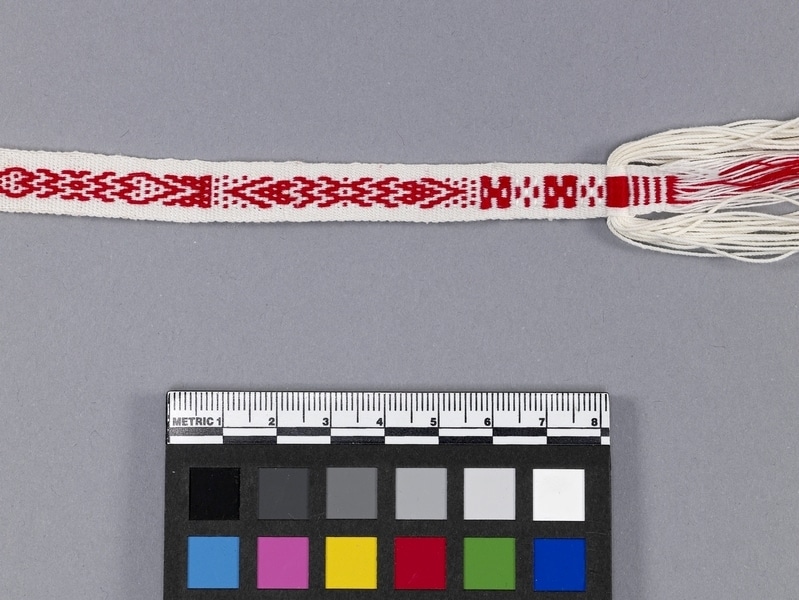Band Item Number: Edz906 from the MOA: University of British Columbia


Description
Long thin band with woven pattern. The pattern repeats a geometric motif within rectangular blocks in red on white ground. The warp is circular, left unwoven for one third of length. At either end of unwoven section there is a pair of tassels of white cotton thread inserted through warp.
History Of Use
Worn by Hakka women to fasten on their rectangular head cloths. Doubled over the top of the head cloth and tied under the back with a piece of string. Hakka women were known for their ability to do heavy labouring work outdoors. Their clothing in general was plain, decorated only with the hand-woven bands worn on their aprons, head cloths, and hats. After the mid-twentieth century the New Territories of Hong Kong began to undergo fundamental changes. The people who had been settled there before 1898, when the British colonizers claimed the area, began to give up rice agriculture and coastal fishing, turning instead to wage labour and increased employment overseas. By the end of the century, educational opportunities leading to the possibility of white-collar work also increased, together with western influences. These changes meant that objects and clothing once useful and appropriate were no longer needed and generally were discarded. Some were saved by their owners, who sometimes were willing to donate them to museums, sharing, also, their knowledge of how they were made and used. By the late 1960s, women were giving up traditional Chinese-style clothing in favour of western-influenced blouses and pants.
Iconographic Meaning
Red colour indicates the wearer is unmarried and probably young, as red is rarely worn by elderly women. Zigzag pattern shows the wearer comes from Tai Po area.
Narrative
This patterned band was purchased new in Tai Po market. Hakka people are one of the two original land-dwelling groups that settled the area that became the New Territories of Hong Kong. Their spoken language, and some customs, differed from those of the other original group, the Cantonese or Punti. The Cantonese arrived first and settled on the best rice-growing lands, while the Hakka began to arrive after the late 17th century and settled the more hilly lands.
Cultural Context
Worn by Hakka women.
Specific Techniques
The weaver first set up the warp by winding a series of circles in the order of the colours in which she wanted them to appear in the finished band. They were wound between a finger of her left hand and the corner of a stool that held them taut. She then tied the ends of the threads so that a continuous circle was formed, and inserted a chopstick through the end of the circle and tucked it into a belt tied around her waist to keep the warp taut and her hands free. She then created a shed by taking a piece of bamboo about 10 cm long and 1 cm in diameter and winding the warp threads alternately around it above and below. The centre warp threads were wound in pairs and those on the edges singly, as the pattern would be picked only in the centre panel, while the edges often were striped. She then made a bar heddle, using a dagger-shaped beater made from a smooth piece of wood, often from a broken carrying pole. The purpose of the heddle was to raise the lower warp threads. She used the beater to raise these threads and hold them, while a loop of strong thread was made between each pair of threads and the weaver’s hand. When all the loops had been made they were secured with a piece of strong grass that served as a handle. She then wove four lengths of strong grass (lease rods) near the end of the warp nearest to her body, to prevent the warp from being tangled. She then made one or more tassels from equal lengths of thread, knotted in the centre, and passed them through the warp, secured with rows of weaving on each side. She then wove the band, weaving the edges in plain weave and using the beater to pick any of various complex patterns in the centre of the band. The band was finished with the insertion of another set of tassels, and about one quarter of the total length was left unwoven to add more bulk to the tassels. The band was cut in the centre of the unwoven part.
Item History
- Made in Tai Po, Hong Kong, China before 1976
- Collected during 1976
- Owned by Elizabeth L. Johnson before September 2, 1976
- Received from Elizabeth L. Johnson (Donor) on September 2, 1976
What
- Name
- Band
- Identification Number
- Edz906
- Type of Item
- band
- Material
- cotton fibre and dye
- Manufacturing Technique
- woven
- Overall
- height 44.0 cm, width 1.0 cm
Who
- Culture
- Chinese: Hakka
- Previous Owner
- Elizabeth L. Johnson
- Received from
- Elizabeth L. Johnson (Donor)
Where
- Holding Institution
- MOA: University of British Columbia
- Made in
- Tai Po, Hong Kong, China
When
- Creation Date
- before 1976
- Collection Date
- during 1976
- Ownership Date
- before September 2, 1976
- Acquisition Date
- on September 2, 1976
Other
- Item Classes
- textiles
- Condition
- good
- Accession Number
- 0328/0005